
Telfes is a village in the district Innsbruck Land in the Austrian state of Tyrol. It is situated in the Stubaital 11 km south of Innsbruck.

Ampass is a municipality in the Innsbruck-Land District, Tyrol (Austria) situated at an altitude of 651 m, has an area of 7.9 km2 and 1793 inhabitants as January 2015.

Oberperfuss is a municipality in the district of Innsbruck-Land in the Austrian state of Tyrol located about 15 km (9.3 mi) west of Innsbruck at the entrance of the Sellrain Valley. It was mentioned in documents around 1083 for the first time.
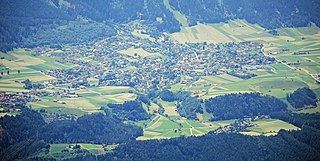
Axams is a municipality in the district of Innsbruck Land in the Austrian state of Tyrol.

Ellbögen is a community in the district of Innsbruck Land and lies 12 km south of Innsbruck. It is a scattered village located on the eastern valley side of the Wipptal.

Gries am Brenner, often referred to as simply Gries, is a municipality in the Wipptal in the southern district of Innsbruck-Land. The village consists of several hamlets.

Grinzens is a municipality in the Austrian state of Tyrol in the district of Innsbruck-Land. As of January 2015, its population is 1414. It lies southwest of the city of Innsbruck at an elevation of 945 m.
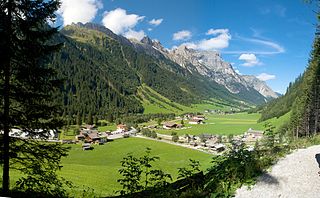
Gschnitz is a municipality with 415 inhabitants in the south of North Tyrol.
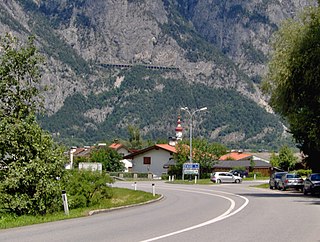
Kematen in Tirol is a municipality in the district Innsbruck-Land located about 12 km west of Innsbruck. The Melach river flows into the Inn river in Kematen. Kematen was first mentioned as "Caminata" around 600.
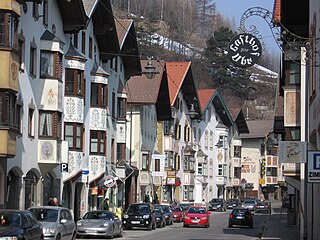
Matrei am Brenner is a small municipality in the southern part of the District Innsbruck-Land and is located approximately 17 km south of Innsbruck. Matrei has always been an important station for commerce. On 1 January 2022 the municipalities of Pfons and Mühlbachl were merged into Matrei. The village has 3,500 inhabitants, at 992 m. above sea level and the Sill river flows through it.

Mieders is a municipality in the southern part of the district Innsbruck-Land in the Austrian state of Tyrol. It is located on the right side of the Stubaital 10.60 km south of Innsbruck.

Navis is a municipality in the district Innsbruck-Land in the Austrian state of Tyrol located 19 km southeast of Innsbruck in a valley with the same name which is a side valley of the Wipptal. The extensive territory of this municipality runs from the Sill up to the 2,359 m high Klammjoch saddle and the 2,886 m high Lizumer Reckner in the Tux Alps. The village is provided with fresh drinking water thanks to the clean Navisbach. The origin of the village name is unknown but settlement began at the end of the 13th century. Copper and silver were found in the 15th and 16th century.

Neustift im Stubaital is a municipality in the district Innsbruck-Land in the Austrian state of Tyrol. It is the third largest municipality of Tyrol in area. It is a major tourist centre, with more than 1 million overnight stays per year.

Obernberg am Brenner is a municipality in the southern district of Innsbruck-Land in the Austrian state of Tirol.

Unterperfuss is a municipality in the district of Innsbruck-Land in the Austrian state of Tyrol located 15 km west of Innsbruck and is one of the smallest villages of Tyrol. The area is restricted in the north by the Inn River and in the east by the Melach River. Unterperfuss has many facilities for horse-riding.

Steinach am Brenner is a market town in the district of Innsbruck-Land in the Austrian state of Tyrol located south of Innsbruck in the Wipptal at the Sill River.
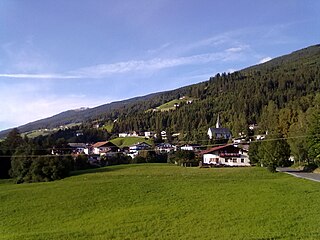
Pfons was a municipality in the district of Innsbruck-Land in the Austrian state of Tyrol located 13.7 km south of Innsbruck in the Wipptal at the Sill River. Although it is not exactly clear where the name of the village comes from, the location was first mentioned as “Phunzun” in 1030 and later as “Phanes” in 1177. Formerly a part of Matrei am Brenner, Pfons was declared as independent in 1811. On 1 January 2022 Pfons and Mühlbachl were merged into the municipality of Matrei am Brenner.

Sellrain is a municipality in the district of Innsbruck-Land in the Austrian state of Tyrol located 14.40 km (8.95 mi) southwest of Innsbruck in the Sellrain Valley. The River Melach and its tributary the Fotscherbach flow through it. Most inhabitants are farmers and also have another job in the neighboring Innsbruck. There are two Catholic churches in the village St. Quirin and St. Anna. They are both over 300 years old.

Schmirn is a municipality in the District Innsbruck-Land in the Austrian state of Tyrol.

Ranggen is a municipality in the district of Innsbruck-Land in the Austrian state of Tyrol located 12 km west of Innsbruck. The location was mentioned as “Fergen” in 1482 for the first time. Ranggen has 17 parts.






















